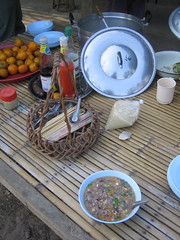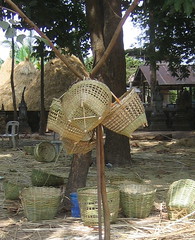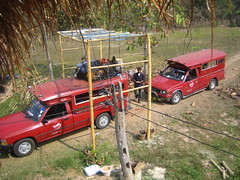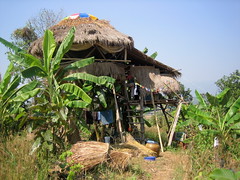Urbanites In The Edible Forest
Part six in a series of stories from my road trip in Thailand, participating in a study tour hosted by Pun Pun farms, to visit local examples of sustainable living in the Northeast and in Chiengmai.
The Education of the Not Sustainable
On our free day, before leaving Isaan, Jo invited us to go with him into his village. We had had our breakfast of vegetarian rice soup in soy milk and washed our dishes at the lineup of four basins, one of soapy water and three of rinse water leaving them to dry on the split bamboo drying platform. To keep the self-herding cows from wandering into the fenced off dining area, we pulled a long tree branch across the gateway. Jo walked with his 3 year-old-boy Than down the dirt road into the village. I followed close behind walking with Sasha one of the American year-abroad students studying at Chiengmai Univiersity.
"Throw that away it's dirty," Jo said to his bilingual son in Thai; Tahn had stopped to pick up a piece of plastic trash from the road. I recognized the word sockobroc meaning dirty, one of the few multi-syllable words in Thai.
"Yes it is," I replied, instinctively in Thai, remembering such conversations from my childhood. I asked Jo in English why he left his village. He told us how he had gone to Bangkok to live in the temple system and further his education at the University level. He shook his head.
"Farmers should not go to university," he said, "what is taught there is not sustainable. What good is it for a farmer to have an education if he is not taught how to be sustainable?" I glanced at Than wondering how this boy would be educated. I was certain that the American side of his family wouldn't see it that way. My own education had been a source of contention between my English mother and my Thai grandma; education was what determined the national allegiance of biracial children. I was one of the few to receive an English education. But not to aspire to higher education at all was iconoclastic for both nations. How did one become upwardly mobile without education? How did one have freedom of choice?
Yet I understood what Jo was saying. Perhaps an education was just another form of runaway consumerism training students to increase their needs and consume more resources in order to "succeed". What, indeed, was sustainable about it? What was progress for a Thai farmer if the use of modern agriculture meant endless debt and health problems from pesticide use? Those living in slums in the city would certainly be better off if they had been able to stay in the village.
"That would be like the Amish," I said. Jo didn't know about the Amish. I explained that they were farmers in America who did not educate their children beyond the 8th grade. "Hmm," he said, but did not ask me any questions.
Sasha and I began to walk faster, pulling ahead of Jo, to confide in each other that we couldn't agree with such a no higher education decree. It was too late for us. I was addicted to knowledge—to understanding how the world worked. Sasha, I would find out later, had been pre-med and after reading Michael Pollan's book, The Omnivore's Dilemma, had switched to agrobiology hoping to discover how the modern world could become sustainable. We both believed that we had to go forward in search of solutions through more education. We in the first world had gone so far into an unsustainable way of living that we had nothing to go back to; our built world of freeways and supermarkets made it impossible. I wondered if it had also made it impossible for our minds to grasp what we must do to live sustainable. So sure were we that technology would allow us to beat the limitations of natural resources.
The Pillow Village
My thoughts were interrupted with our arrival at a pillow-selling household. Jo's village made pillows, the traditional triangle pillow Thai people bought to lean against while sitting on the floor, also a popular tourist buy. A giant replica of such a pillow could be seen in the town centre. Throughout the village we had spotted individuals sitting by themselves stuffing kapok into the narrow channels of the pillow casing.
Pillows were not the only products made here. We next visited a carpenter who had built a roadside cafe in his front yard with furniture made from tree branches from fallen trees. His patrons had admired his rustic furniture so much he began selling his pieces and making more. At the local temple we came upon a group of men shaping long strips of bamboo into woven baskets to sell at an upcoming fair. There were baskets for different tasks including one for catching eel. In the days before plastic buckets, Jo explained, the villagers used latex from trees to make their baskets waterproof.
What an idyllic place to work, I noted looking up at the tall trees shading the group and the picturesque stupas in the background.
"If I lived in this village for a year do you think I could learn how to make all these baskets," I asked Jo.
"You could learn it in a month," he assured me.
Urbanites In The Edible Forest
To counter the damage left by conventional education, Jo and Peggy had, together, built a center to teach sustainable methods of farming and living to Thai people for free and to Westerners for enough money to support the endeavor. Originally envisioned as a seed saving center, the farm was named Pun Pun meaning a thousand varieties. It was just outside of Chiengmai, the northern capital of Thailand 8 hours by overnight bus from Issan.
Upon our arrival in Chiengmai, we stopped at a large local temple to eat a meal at the organic restaurant Peggy and Jo had helped start in order to create a market for the organic food they wanted to encourage farmers to grow. Surrounded by the white walls of the temple compound the local vegetarian dishes we were served were indeed heavenly—tarot root covered eggs, soups, spicy salads and flavored red rice.
Another hour's travel by two bench pick-up truck and we arrived at Pun Pun nestled in the hills above a local village. At dinner that night it seemed as if our group had swelled to twice its size as the remaining interns joined us. My buddies and I were quiet as we took in all the new foreigners who had spent 10 weeks at the farm in the most comprehensive program Peggy and Jo had to offer.
It was through this internship that I had heard about the center several years ago. A friend of a friend had been raising funds so that she could attend their program. I was rather skeptical of the outfit, at first, and had pictured a poor village where eager young Americans would soon succumb to traveler's diarrhea. (I did not, on this trip, though we drank rain water stored in giant ceramic jars.) They had a website and over the years I watched as they developed their program. When they offered the sustainability tour I could finally fit in the time to come.
The farm had an odd effect on me. The terrain was familiar in a way that evoked my childhood yet it had a hippie flavor to it that was Western. As I walked along the dirt paths, from sleeping hut to dining pavilion, I kept wondering why I had not found such a place when I was young, but, of course, there was nothing like this offered in Thailand when I was the same age as these interns. Peggy and Jo had, themselves, only owned the land five years.
When they bought the farm, the land was rough and considered infertile having been clear cut of the original forest. Only grass and prickly weed grew there. There was no electricity or water. They lived at neighbors while developing the farm. This included digging ponds and planting banana trees for the moisture and organic matter, which they then used for mulch around fruit trees. It was two year before the bananas produced fruit. Now they were hanging in the pavilion for us to eat. They also grew papayas and melons and most of the food eaten at the farm.
A woman named Yao, who had cooked for the farm, told us her story about how Jo hadn't given her any money to buy food to cook with and she realized that he expected her to forage for ingredients. She had had to reinvent dishes to use what vegetables were available and in season. Later she and her husband bought the land next door and she now teaches a cooking course there along with offering cheap lodgings to the backpacking crowd. She had specifically chosen to offer cheap lodgings because the clientele in this income bracket were so much friendlier and appreciative than the high-end client looking for services and amenities, she told us. The guesthouses were whimsical and charming adobe huts.
Yao had left a career in the film industry and an urban life to escape to this hilltop resort where the world would come to her in the form of travelers. I had never thought of it that way, having feared that a life in the country would isolate me. Her story told me a lot about how an urban Thai could change her stripes. The name of her guesthouse resort was You Sabai which means "stay in comfort" only the Thai word for comfort defies definition, evoking, for me, soft tropical breezes and not a care in the world. The view from the guesthouse cafe took in the lush green valley and reminded me of Kauai.
On the other side of the farm was another escapee from a conventional life. He was an American who had been a teenager when his parents brought him to Thailand to live while they took jobs teaching. Although he had not learned Thai as a teenager he had been fond enough of his experience to devise a way to come back and live here. He had persuaded 11 friends to help him buy his ten acres as a sort of timeshare. It had only taken $4,000 to get him started with Panya (means wisdom). We toured his organic garden, his building projects including a meeting hall and four composting toilets, his oversized pond that hadn't quite sealed properly and his kitchen with its cob oven. He looked like he needed a vacation. It was his ambition to develop a permaculture training center. He lived, he told us, with a sense of impermanence reflecting the changes in government policies regarding foreigners owning land in Thailand.
We also met Josh, from Oakland, who lived on Pun Pun part of the year and was looking for venture capital, the rest of the time, to fund his low tech water purification system. With the goal of helping local farmers filter out the incredible load of pesticides in their irrigation water, he had designed the system using readily available gravel, sand and charcoal contained in locally made cement water pipes, stacked to form tanks. The system ended with a small ultraviolet disinfection unit he had made himself. He was a chemical engineer so he knew what he was doing. I also noted that, unlike most of the interns, he kept a very tidy and organized hut. On the door was a sign posted saying it was the headquarters of Aqueous Solutions, his business name. It was the tiniest, sweetest adobe hut we had seen and had a sleeping loft under the thatched roof accessed by a ladder outside. Inside was a desk with a laptop, a chair, a bicycle and a mission. Really what more did one need?
When I met the Dutch man with the feminine sounding name pronounced Michelle and spelled Michale, I had no reasonable answer when he asked me why I, too, was not living like this in Thailand. We had been invited up to his circular bamboo home, of his own design, built on stilts at the bottom of the You Sabai guesthouse land. With a colorful giant golfing umbrella covering the top of the roof, it evoked the Robinson Crusoe house at Disneyland.
Michale had also lived in the States for several years, but he found the people to be rather unenlightened and the onus of a failing empire to be cumbersome, so he had taken up his travels until he came to You Sabai and built his house. He intended to stay permanently. My mind sea-sawed between the beach hut vision of his silly house and the middle class encumbrances of mine, now equipped with a giant flat screen TV Catherine had bought the night before I left. Was I, like Jo and Peggy, going to have to have both? Our sustainable efforts in Thailand to be canceled out by the air miles to get to and from the US? What if we are frozen in one place or the other by gasoline shortages, I asked Peggy who traveled every year with Jo and Than to Colorado. She didn't have an answer.
This question of fossil fuel use plagued me. All of us had traveled many air miles to get to Pun Pun, many planned to continue traveling extensively throughout Asia, yet we were all wishing to live more sustainably. How could we justify this? Finally I came to see it this way. We, who were so privileged, had an allotment of oil accessible to us. Most would squander it before being forced to give it up. We, at least, had used it to expand our ability to envision a sustainable lifestyle. Those on the tour had lived for these 12 days in a way most travelers seldom experienced (and I haven't even reported on that contentious topic of American travelers—the toilets). I now understood in a profound way what it meant to live in harmony with the earth. It was a way that all the green effort of high tech living couldn't even begin to touch.
Next week I visit Peggy and Jo in their American home, a family compound of green buildings they have constructed themselves and will see, for myself, how their vision translates to the first world.
Also posted at the energy bulletin
Labels: eco-living, Isaan, sustainable, Thailand, travel








